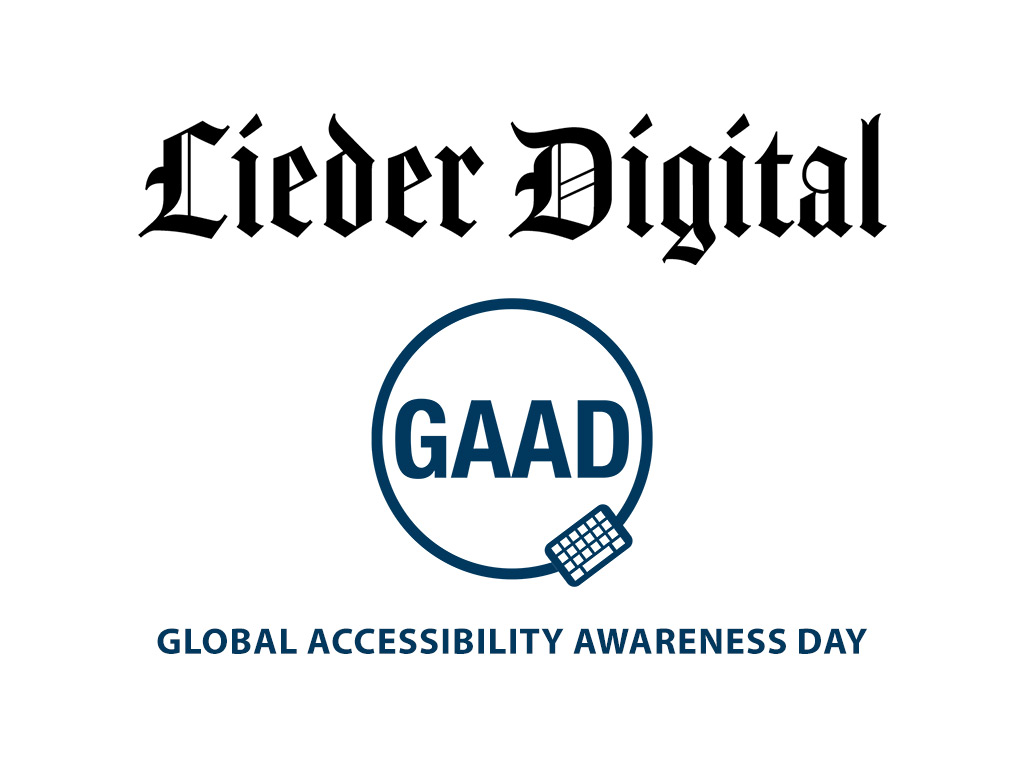Today is Global Accessibility Awareness Day (GAAD)! This little-known event is being celebrated by people in the web design/development world to help bring awareness to one of the biggest challenges with technology: ensuring that people with disabilities can still access and use the same digital tools the rest of us rely on every day. Digital accessibility, according to the folks at the foundation that runs GAAD means:
“Someone with a disability must be able to experience web-based services, content and other digital products with the same successful outcome as those without disabilities.”
Global Accessibility Awareness Foundation
Lieder Digital began providing web accessibility services in 2017, and it’s still a big part of what we’re doing five years later. A lot of what this involves is reviewing websites that have already been designed and built but have a lot of accessibility problems that prevent people with disabilities from using them, finding those barriers to access, and helping organizations either fix their existing websites to make them accessible, or build new ones.
Many people might be surprised to find out that even in 2022, the state of web accessibility is really, quite pathetic. The WebAIM Million project (a study run by the Institute for Disability Research, Policy, and Practice at Utah State University) shows that even this year, 96.8% of the home pages on the one million most popular websites on the internet have web accessibility issues. That’s awful.
Websites (and all kinds of digital products and properties, in fact, including apps, kiosks, touch-screen menus, and more) even in 2022 can still be extremely challenging for users relying on assistive technology (AT). In practice, this is mainly due to things like:
- Low contrast text
- Images without alternative text (“alt text”)
- Empty links
- Missing form input labels
- Empty buttons
- Lack of captions on videos
All of these are a problem, because, if someone is relying on a screen reader to read out what’s on the page but there isn’t enough text on the page for the screen reader to read, it… can’t read the screen. Obviously. If someone without vision is trying to watch a video but there’s text on the screen, that user won’t be able to understand what’s happening. If someone who can’t hear is trying to watch a video but there are no captions, that user won’t be able to understand the content. Get it?
It’s a real challenge, partially because so many of the people designing and building websites, and creating content after a website is launched don’t have the same disabilities, so they don’t even think about it. After all, if you never read captions on videos, why would it enter your mind to think about captions? You probably don’t even remember they exist because you just ignore them. Or even if you do think of captions, do you know how to generate them, and publish them alongside a video in an accessible way? These are complicated questions that are a lot harder than most people initially think.
So what can be done about this? For one, bringing awareness to the issue. Which is exactly what GAAD is all about. I’ve tried to do this for several years, talking about it when I have opportunities to do so. For example, I gave a presentation in 2020 at the Boulder WordPress Meetup called “Accessibility For Web Designers,” where I tried to explain the basics of web accessibility to the people I know who are designing and building websites. It’s not enough to put a dent in the million websites I mentioned before, but it’s a start.
Video Transcript (opens in new window)
I’ve partnered with the team at the Rocky Mountain ADA Center several times over the years, and we’ve worked together to help organizations and municipalities bring their web properties into alignment with the WCAG (Web Content Accessibility Guidelines). This is a set of criteria by which the level of accessibility of a website (or what is technically called an “internet property”) can be objectively measured.
As you might be able to guess, usually, there are a lot of problems that I uncover using the guidelines. It’s a pretty complicated type of project, and the work can get really tedious, but it’s in important job with real, actual human beings on the other end of it who will benefit from what we’re doing.
By the way, in case you’ve seen websites with little blue circles of a person sitting in a wheelchair that looks like a button you can click on to “make the website more accessible,” don’t fall for the hype. Those are called “accessibility overlays,” and they simply do not work.

In fact, I’m a signatory of the Overlay Fact Sheet which is a strongly worded document with a conclusion that I fully support: that using an accessbility overlay or widget is NOT a solution for making a website accessible. I’ll try to write more on that at another time, but suffice it to say for now that web accessibility is a big challenge, even in 2022, one that there are no “magic button” solutions for, and it’s a challenge I’m glad to be a part of.
So, Happy Global Accessibility Awareness Day! Let’s hope the web gets better and more accessible every year.
Ron Stauffer is a web guy and digital marketer with a passion for helping small businesses grow. He has spent over 16 years working in the digital marketing field, building websites, creating marketing strategies, and growing traffic and revenue for small businesses across the USA. His motto is “data wins arguments,” and he uses data visualization tools and charts and graphs to track everything and prove the value of his marketing efforts for clients. Connect with Ron on LinkedIn or visit Lieder Digital online.

